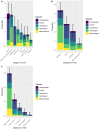Traits and risk factors of post-disaster infectious disease outbreaks: a systematic review
- PMID: 33692451
- PMCID: PMC7970931
- DOI: 10.1038/s41598-021-85146-0
Traits and risk factors of post-disaster infectious disease outbreaks: a systematic review
Abstract
Infectious disease outbreaks are increasingly recognised as events that exacerbate impacts or prolong recovery following disasters. Yet, our understanding of the frequency, geography, characteristics and risk factors of post-disaster disease outbreaks globally is lacking. This limits the extent to which disease outbreak risks can be prepared for, monitored and responded to following disasters. Here, we conducted a global systematic review of post-disaster outbreaks and found that outbreaks linked to conflicts and hydrological events were most frequently reported, and most often caused by bacterial and water-borne agents. Lack of adequate WASH facilities and poor housing were commonly reported risk factors. Displacement, through infrastructure damage, can lead to risk cascades for disease outbreaks; however, displacement can also be an opportunity to remove people from danger and ultimately protect health. The results shed new light on post-disaster disease outbreaks and their risks. Understanding these risk factors and cascades, could help improve future region-specific disaster risk reduction.
Conflict of interest statement
The authors declare no competing interests.
Figures








References
-
- World Health Organization. The top 10 causes of death (2018). https://www.who.int/news-room/fact-sheets/detail/the-top-10-causes-of-death. Accessed 19 June 2020.
-
- World Health Organization. Disease outbreaks (2020). https://www.who.int/ environmental_health_emergencies/disease_outbreaks/en/. Accessed 6 December 2019.
Publication types
MeSH terms
Grants and funding
LinkOut - more resources
Full Text Sources
Other Literature Sources
Medical

